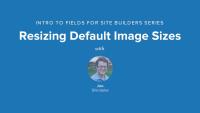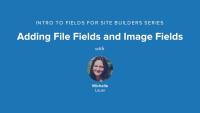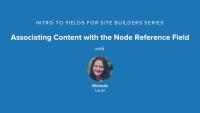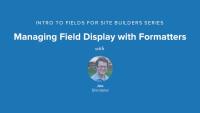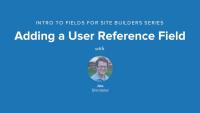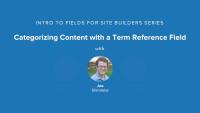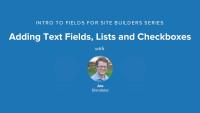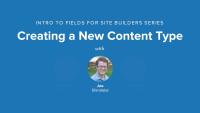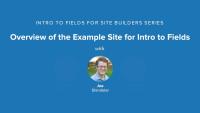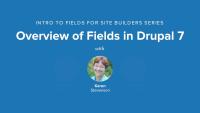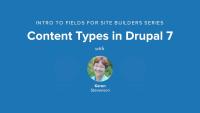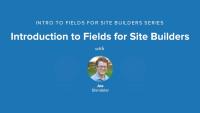Overview of Views
FreeBack in the olden days of Drupal, we used to write raw SQL. Now, Views does all of this for us. Views allows you to create a list of only the content that you want, based on criteria that you define.
In this video we demonstrate the first things to do when creating a View: selecting our Base Table, specifying the Display, looking at Advanced Features to filter content, and specifying the HTML output.
Throughout the course of this series, we're going to start with the content types and fields that we created during the Intro to Fields for Site Builders video series. We'll continue the job board example, and create unique listings.
Our apologies! The audio on this video is really bad and hard to listen to because of some background hissing. On top of that, the transcript interface using the "T" icon is broken on this video. Double-boo! Here is the text of the audio. Note: You can also mute the audio and display the captions by clicking the "cc" icon on the lower right corner of the video player.
Views is the most popular contributed module. In the subsequent chapters, we'll show you step-by-step how to use Views.
Views is a query builder that makes lists of your content. But what does that mean? Let's pretend we're looking for a new car. And we want our salesperson to only show us green cars. No, let's make that blue cars. Or maybe, we only want to see trucks.
Think of all of your content as this giant parking lot. Views allows you to create a list of only the content that you want, based on the criteria that you define. And you can concatenate this criteria. You can say, show me all the content that is of the type, article and, authored by the admin user.
Back in the olden days of Drupal, we used to write raw SQL. Now, Views does all of this for us. To create a list of content on our site, we don't need to know anything about the database at all. Views will give us an administrative interface where we can click around to configure our criteria, and also how we'd like it to be output. The previous slide showed us that there are a lot of options to select from. But in basic terms-- Views sucks data in, fires off magic thingies, and then outputs hotness.
When creating a View, the first thing that we select is our Base Table. This is the pool of data from where we want to start creating our lists. Do we want to show information about nodes, or users, or comments, even. And then we can select what we'd like our first Display to be. Should our list to be a page, with a unique URL. Or a block, that we can place in any region in our site. For a Display, in addition to selecting the filter criteria, we can specify which fields we want to appear. And also, what order we'd like our content listed. Advanced Features allows us to filter content based on a current condition-- like the URL, or the logged-in user.
We also can gather information that is related to our current result. Views allows us to have multiple displays for each View. For each subsequent Display you create, it will inherit the configurations of your first Display. Although the new Display utilizes your previous settings, you can override that. Once we've selected our Base Table, and configured our Display settings, Views will also allow us to specify the HTML output. We can choose from a simple div structure, and ordered lists, or even a table.
Views is a powerful and highly-configurable list maker. Throughout the course of these videos, we're going to take the content types and fields that we created during the Intro to Fields for Site Builders video series. We'll continue the job board example, and create unique listings. The Views module contains so many configurations and settings. Through our practical examples, we aim to demystify it. So let's dive in.
Additional resources
Shows the interface for adding fields to other entities such as taxonomy terms, comments and users. Walks through the process of adding a user profile field that will show up on the user registration form and appear on the user's profile page.
Shows how to configure image styles for the uploaded headshot in order to resize the image to a more reasonable and standardized size.
Shows how to set up private files in Drupal 7 and custom upload path as well as how to set up an image field.
Shows how to associate and create a relationship between two nodes with the node reference field type, and how to set up the node reference URL widget in order to auto-populate the node relationship via a link on the referring node.
Shows how to change the formatting and label display for fields, and how to control whether a field appears in the teaser, full mode, search results and other display mode contexts.
Goes through the process of adding a role and then creating a user reference field, which autocompletes to users within that specified role.
Goes through the process of creating a hierarchical set of taxonomy terms, and then adding an autocomplete taxonomy term reference field to a content type.
Recently we announced that we'd be rolling out series of shorter videos to make it easier to find and view the information you want. Now that we have the structure in place for shorter videos, we have gone a step further and broken our existing long videos into series as well. Aside from making it easier to navigate the videos and providing a smoother playback experience, this also gave us the opportunity to offer some of the chapters for FREE!
Over the next couple of weeks, we're going to be publishing a new video series for site builders on extending content types with fields. It's on Drupal 7, and is a great introduction to the new interface in Drupal 7 for configuring content types and fields, and it will be paired with a complementary series on the new interface of Views 3 for Drupal 7.
Goes through the process of adding three new fields to the job posting content type including an integer text field for the salary, a select list of job type, and a checkbox as to whether or not telecommuting is allowed.
Goes through the process of creating a new content type of a job posting, and shows how to customize the Title and Body labels for this new content type.
Provides an overview of the example job posting site that will be built over the remaining chapters of this video series. Joe gives a tour of the job posting content type as well as the job application content type.
Gives a high-level overview of the field configuration page and defines the field types, widget and display formatters. Also adds a simple text field as an example of extending an existing content type.
Goes through the default content types of the Article and Page that are provided in Drupal 7, and shows the similarities and differences between the two. Also goes through some of the configuration options, which define the default settings whenever a new node is created.
Let’s talk about taking your image uploads and turning them into unique shapes with fabulous effects using the ImageCache Actions module.
We already know that being able to set a standard for image display creates consistency and a better user experience. Drupal comes with the ability to do basic image manipulation like resizing them. By downloading and enabling another module, ImageCache Actions, we can do fancy things to those images, making your display truly customized.
I am assuming that you already know how to create Image Style presets.
For this tutorial, you need to make sure the Image module that comes with Drupal Core and you also need to download and enable the ImageCache Actions module. This can be found at drupal.org/project/imagecache_actions.
In this video series, Joe Shindelar, Karen Stevenson and Michelle Lauer build out a job posting board using the built-in Fields in Drupal 7 along with some other contributed modules. They cover the basics that Site Builders need to know about how to add fields, configure how they're displayed, and using all of the different types of fields including file files, image files, term references, node references, and user references. Each chapter of this video builds upon the last as the team builds and configures two content types for posting available jobs and job applications.
In this video, Joe shows the finished project we're going to make together through this series. Later in the series we'll be going through the steps necessary in order to create the job posting and job application content types he demonstrates here.
This video will pair well with Intro to Views in Drupal 7, which will continue this job board project through to completion.
Introduction to Drush
Blog postExperienced developers, and new site builders alike can remember a time when installing a module meant visiting it's project page on drupal.org, downloading and unpacking it and dropping it in the correct directory. That process can be quite tedious every time there's an update if your site has dozens of modules. Thank goodness for drush. While drush's utility certainly isn't limited to helping download modules for your site in an efficient manner, it's an absolutely invaluable tool for anyone working with Drupal sites on a regular basis. We're happy to present a new series, Introduction to Drush, with the first video, What is Drush?, released today.


